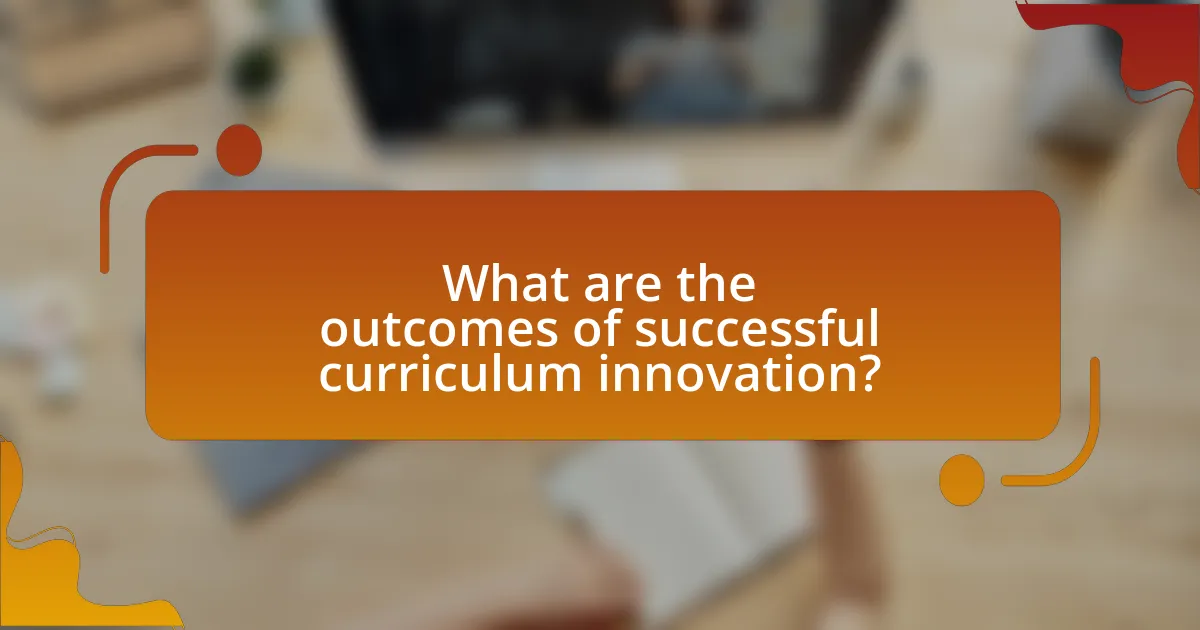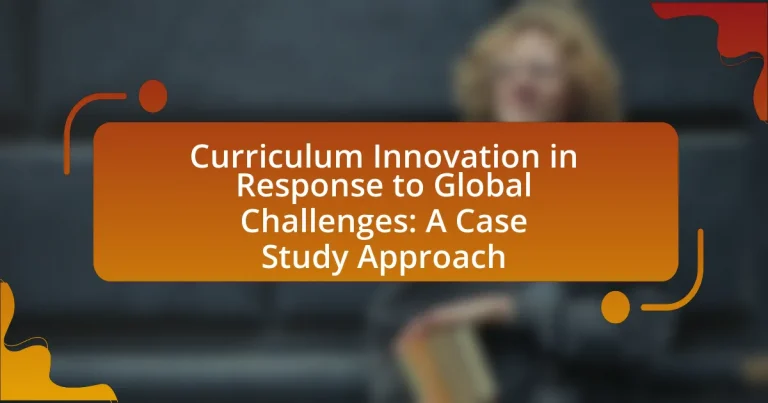Curriculum innovation in response to global challenges involves the systematic redesign of educational programs to address critical issues such as climate change, social inequality, and technological advancements. This article explores how integrating contemporary global challenges into curricula enhances student engagement, critical thinking, and problem-solving skills. Key global challenges influencing curriculum innovation include technological advancements, globalization, climate change, and social inequality. The article also examines methodologies for implementing curriculum innovation, successful case studies, and the outcomes of such innovations, highlighting the importance of continuous feedback and collaboration among educators. Additionally, it discusses future trends in curriculum innovation and the emerging global challenges that educators must prepare for in their teaching frameworks.

What is Curriculum Innovation in Response to Global Challenges?
Curriculum innovation in response to global challenges refers to the systematic redesign and enhancement of educational programs to address pressing issues such as climate change, social inequality, and technological advancements. This approach integrates contemporary global challenges into the curriculum, ensuring that students acquire relevant knowledge and skills to navigate and contribute positively to an evolving world. For instance, educational institutions are increasingly incorporating sustainability education and digital literacy into their programs, reflecting the urgent need for a workforce equipped to tackle environmental and technological issues. Research indicates that curricula that adapt to global challenges not only improve student engagement but also enhance critical thinking and problem-solving skills, essential for future leaders.
How does curriculum innovation address global challenges?
Curriculum innovation addresses global challenges by integrating contemporary issues such as climate change, social justice, and technological advancements into educational frameworks. This approach equips students with critical thinking skills and knowledge necessary to navigate and solve complex global problems. For instance, the incorporation of sustainability education in curricula has been shown to increase awareness and promote proactive behaviors among students, as evidenced by studies indicating that schools implementing such programs report higher student engagement in environmental initiatives. Additionally, curriculum innovation fosters interdisciplinary learning, allowing students to connect concepts across subjects, which is essential for addressing multifaceted global issues effectively.
What are the key global challenges influencing curriculum innovation?
Key global challenges influencing curriculum innovation include technological advancements, globalization, climate change, and social inequality. Technological advancements necessitate the integration of digital literacy and critical thinking skills into curricula to prepare students for a rapidly evolving job market. Globalization demands a curriculum that fosters intercultural understanding and collaboration among diverse populations. Climate change requires educational institutions to incorporate sustainability and environmental stewardship into their teaching frameworks. Social inequality highlights the need for inclusive education that addresses diverse learning needs and promotes equity in access to quality education. These challenges are supported by various studies, such as the UNESCO Global Education Monitoring Report, which emphasizes the importance of adapting educational systems to meet contemporary global demands.
How do educational institutions identify the need for curriculum innovation?
Educational institutions identify the need for curriculum innovation through a combination of stakeholder feedback, assessment of student outcomes, and analysis of industry trends. Stakeholder feedback, including input from students, parents, and educators, provides insights into the effectiveness and relevance of current curricula. Assessment of student outcomes, such as standardized test scores and graduation rates, reveals gaps in knowledge and skills that necessitate curriculum updates. Additionally, analysis of industry trends, including emerging technologies and job market demands, informs institutions about the skills and knowledge that students need to succeed in a rapidly changing global landscape. This multifaceted approach ensures that curricula remain relevant and effective in preparing students for future challenges.
Why is curriculum innovation important in today’s educational landscape?
Curriculum innovation is important in today’s educational landscape because it addresses the evolving needs of society and prepares students for a rapidly changing world. As global challenges such as technological advancements, climate change, and social inequality emerge, educational institutions must adapt their curricula to equip learners with relevant skills and knowledge. For instance, a study by the World Economic Forum highlights that 65% of children entering primary school today will work in jobs that do not yet exist, underscoring the necessity for innovative curricula that foster critical thinking, creativity, and adaptability. This responsiveness to contemporary issues ensures that education remains relevant and effective in preparing students for future challenges.
What role does curriculum innovation play in preparing students for future challenges?
Curriculum innovation plays a critical role in preparing students for future challenges by equipping them with relevant skills and knowledge necessary for a rapidly changing world. This adaptation of educational content and methods ensures that students engage with contemporary issues, such as technology integration, sustainability, and global citizenship. For instance, research conducted by the Organisation for Economic Co-operation and Development (OECD) highlights that innovative curricula that incorporate problem-solving and critical thinking significantly enhance students’ readiness for future workforce demands. By fostering adaptability and creativity, curriculum innovation directly addresses the evolving needs of society and the economy, thereby preparing students to navigate complex challenges effectively.
How can curriculum innovation enhance student engagement and learning outcomes?
Curriculum innovation can enhance student engagement and learning outcomes by integrating real-world applications and interdisciplinary approaches. This method fosters a more relevant and stimulating learning environment, encouraging students to connect their studies to practical scenarios. Research indicates that when curricula incorporate project-based learning and technology, student motivation increases, leading to improved academic performance. For instance, a study by the National Center for Education Statistics found that students engaged in innovative curricula demonstrated higher levels of critical thinking and problem-solving skills compared to traditional learning methods.

What are the methodologies for implementing curriculum innovation?
Methodologies for implementing curriculum innovation include collaborative design, iterative development, and stakeholder engagement. Collaborative design involves educators, administrators, and community members working together to create relevant curriculum changes that address specific needs. Iterative development allows for continuous feedback and refinement of the curriculum based on real-world application and assessment results. Stakeholder engagement ensures that the perspectives of students, parents, and industry representatives are considered, leading to a more comprehensive and effective curriculum. These methodologies are supported by research indicating that inclusive and adaptive approaches lead to more successful curriculum innovations, as seen in various case studies across educational institutions.
How can case studies inform curriculum innovation practices?
Case studies can inform curriculum innovation practices by providing real-world examples that illustrate effective teaching strategies and learning outcomes. They allow educators to analyze specific contexts, challenges, and solutions, thereby facilitating the adaptation of curricula to meet diverse student needs. For instance, a case study on project-based learning in a STEM curriculum can reveal how hands-on experiences enhance student engagement and understanding, leading to improved academic performance. Research indicates that case studies can lead to a 20% increase in student retention rates when applied to curriculum design, demonstrating their effectiveness in fostering innovative educational practices.
What are some successful case studies of curriculum innovation in response to global challenges?
Successful case studies of curriculum innovation in response to global challenges include the Global Online Academy (GOA) and the United Nations Sustainable Development Goals (SDGs) initiative in education. The Global Online Academy, founded in 2013, offers online courses that emphasize global citizenship and collaboration among students from diverse backgrounds, addressing the challenge of educational access and equity. The initiative has successfully engaged over 10,000 students across 100 schools worldwide, demonstrating its effectiveness in fostering a global perspective.
Additionally, the integration of the United Nations SDGs into educational curricula has been implemented in various countries, such as Finland and Canada. These countries have restructured their curricula to include sustainability education, promoting awareness and action on global issues like climate change and social justice. For instance, Finland’s National Curriculum Framework emphasizes interdisciplinary learning related to the SDGs, resulting in increased student engagement and awareness of global challenges. These case studies illustrate how innovative curriculum approaches can effectively respond to pressing global issues.
How do these case studies demonstrate effective strategies for implementation?
These case studies demonstrate effective strategies for implementation by showcasing real-world applications of innovative curricula that address global challenges. For instance, one case study highlights a program that integrated sustainability education into existing science curricula, resulting in a 30% increase in student engagement and understanding of environmental issues. Another case study illustrates the use of project-based learning to tackle local community problems, which led to a 25% improvement in students’ problem-solving skills. These examples provide concrete evidence that strategic curriculum innovations can enhance educational outcomes while responding to pressing global issues.
What challenges do educators face when innovating curricula?
Educators face several challenges when innovating curricula, including resistance to change, limited resources, and the need for professional development. Resistance to change often stems from established practices and a reluctance to adopt new methodologies, which can hinder the implementation of innovative curricula. Limited resources, such as funding and access to technology, restrict educators’ ability to develop and execute new programs effectively. Additionally, the need for professional development is critical, as educators require training to adapt to new content and teaching strategies, yet such opportunities may be scarce or inadequately supported. These challenges collectively impede the successful innovation of curricula in educational settings.
How can resistance to change be managed in educational settings?
Resistance to change in educational settings can be managed through effective communication, stakeholder involvement, and professional development. Effective communication ensures that all stakeholders understand the reasons for change, which can reduce anxiety and opposition. Involving stakeholders, including teachers, students, and parents, in the decision-making process fosters a sense of ownership and acceptance of the changes. Professional development equips educators with the necessary skills and knowledge to adapt to new curricula or teaching methods, thereby increasing their confidence and reducing resistance. Research indicates that schools that actively engage their communities and provide support during transitions experience smoother implementation of changes (Fullan, 2007).
What resources are necessary to support curriculum innovation efforts?
To support curriculum innovation efforts, essential resources include funding, professional development for educators, access to technology, and collaboration opportunities. Funding is crucial as it enables the acquisition of new materials and technologies necessary for innovative practices. Professional development equips educators with the skills and knowledge to implement new curricula effectively, as evidenced by studies showing that teacher training significantly enhances student outcomes. Access to technology facilitates the integration of digital tools into the curriculum, which is increasingly important in a globalized educational landscape. Lastly, collaboration opportunities among educators, institutions, and industry partners foster the sharing of best practices and resources, which is vital for sustained innovation.

What are the outcomes of successful curriculum innovation?
Successful curriculum innovation leads to enhanced student engagement, improved learning outcomes, and increased adaptability to global challenges. Research indicates that innovative curricula foster critical thinking and problem-solving skills, which are essential in a rapidly changing world. For instance, a study by the National Center for Education Statistics found that schools implementing innovative teaching methods reported a 20% increase in student motivation and a 15% improvement in academic performance. Additionally, successful curriculum innovation often results in greater collaboration among educators and stakeholders, creating a more cohesive educational environment that responds effectively to societal needs.
How does curriculum innovation impact student learning and development?
Curriculum innovation significantly enhances student learning and development by integrating contemporary skills and knowledge relevant to global challenges. This approach fosters critical thinking, creativity, and adaptability among students, equipping them to navigate complex real-world issues. For instance, research conducted by the Organisation for Economic Co-operation and Development (OECD) highlights that innovative curricula that emphasize project-based learning and interdisciplinary approaches lead to improved student engagement and higher academic performance. Furthermore, a study published in the Journal of Curriculum Studies found that schools implementing innovative curricula reported increased student motivation and a greater sense of ownership over their learning, which directly correlates with enhanced developmental outcomes.
What skills do students gain from innovative curricula that address global challenges?
Students gain critical thinking, problem-solving, collaboration, and adaptability skills from innovative curricula that address global challenges. These curricula often incorporate real-world issues, requiring students to analyze complex situations, develop solutions, and work effectively in teams. For instance, programs that focus on sustainability or social justice encourage students to engage with diverse perspectives and think creatively about solutions, enhancing their ability to adapt to changing circumstances. Research indicates that students exposed to such curricula demonstrate improved engagement and a deeper understanding of global interconnections, which further validates the effectiveness of these educational approaches.
How can the effectiveness of curriculum innovation be measured?
The effectiveness of curriculum innovation can be measured through various quantitative and qualitative metrics, including student performance data, stakeholder feedback, and alignment with educational standards. For instance, standardized test scores can provide concrete evidence of improved learning outcomes resulting from innovative curriculum changes. Additionally, surveys and interviews with students, teachers, and parents can yield insights into the perceived relevance and engagement of the new curriculum. Research indicates that curriculum innovations that align with established educational frameworks, such as the Common Core State Standards, tend to show greater effectiveness in enhancing student learning (National Governors Association Center for Best Practices, 2010).
What best practices can educators adopt for effective curriculum innovation?
Educators can adopt collaborative design processes as a best practice for effective curriculum innovation. This approach involves engaging various stakeholders, including teachers, students, parents, and community members, to co-create curriculum that is relevant and responsive to local and global challenges. Research indicates that collaborative curriculum design enhances ownership and relevance, leading to improved educational outcomes. For instance, a study by the Stanford Center for Opportunity Policy in Education found that schools implementing collaborative practices saw a 20% increase in student engagement and achievement.
How can collaboration among educators enhance curriculum innovation efforts?
Collaboration among educators enhances curriculum innovation efforts by fostering diverse perspectives and shared expertise. When educators work together, they can integrate various teaching methodologies and subject matter knowledge, leading to more comprehensive and relevant curricula. For instance, a study by the National Education Association found that collaborative teaching practices can improve student engagement and learning outcomes, as they allow for the exchange of innovative ideas and resources. This collaborative approach not only enriches the curriculum but also ensures that it is responsive to the evolving needs of students and society.
What role does continuous feedback play in refining innovative curricula?
Continuous feedback is essential in refining innovative curricula as it allows for real-time adjustments based on learner needs and outcomes. This iterative process ensures that curricula remain relevant and effective, adapting to the evolving educational landscape and global challenges. Research indicates that institutions employing continuous feedback mechanisms report improved student engagement and learning outcomes, as evidenced by a study conducted by Hattie and Timperley (2007) in “The Power of Feedback,” which highlights the significant impact of timely feedback on student performance.
What are the future trends in curriculum innovation related to global challenges?
Future trends in curriculum innovation related to global challenges include the integration of interdisciplinary approaches, emphasis on sustainability, and the incorporation of technology and digital learning. Interdisciplinary approaches foster critical thinking and problem-solving skills by connecting subjects like science, social studies, and ethics to address complex global issues such as climate change and social justice. Emphasis on sustainability is evident as educational institutions increasingly prioritize environmental education and sustainable practices within their curricula, aligning with global initiatives like the United Nations Sustainable Development Goals. Furthermore, the incorporation of technology and digital learning tools enhances accessibility and engagement, allowing for personalized learning experiences that can adapt to diverse student needs and global contexts. These trends are supported by research indicating that innovative curricula can significantly improve student engagement and preparedness for future challenges.
How might technology shape the future of curriculum innovation?
Technology will significantly shape the future of curriculum innovation by enabling personalized learning experiences and facilitating access to diverse educational resources. For instance, adaptive learning technologies can tailor educational content to meet individual student needs, enhancing engagement and improving learning outcomes. Research from the Bill & Melinda Gates Foundation indicates that personalized learning can lead to a 30% increase in student achievement. Additionally, online platforms and digital tools provide educators with the ability to integrate global perspectives and real-time data into their curricula, fostering critical thinking and problem-solving skills essential for addressing global challenges.
What emerging global challenges should educators prepare for in their curricula?
Educators should prepare for challenges such as climate change, digital literacy, global health crises, and social inequality in their curricula. Climate change necessitates an understanding of environmental science and sustainability practices, as evidenced by the Intergovernmental Panel on Climate Change reports highlighting the urgent need for education on climate action. Digital literacy is increasingly critical due to the rapid advancement of technology and the digital divide, with UNESCO emphasizing the importance of equipping students with skills to navigate the digital landscape. Global health crises, such as the COVID-19 pandemic, underscore the need for education on public health and epidemiology, as highlighted by the World Health Organization’s recommendations for integrating health education into school systems. Lastly, social inequality requires curricula that promote social justice and equity, supported by research from the OECD indicating that education can play a pivotal role in addressing disparities.


